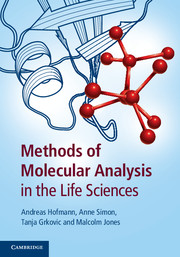5 - Surface-sensitive methods
Published online by Cambridge University Press: 05 July 2014
Summary
Surface plasmon resonance
Surface plasmon resonance (SPR) is a surface-sensitive method for monitoring the smallest changes of the refractive index or the thickness of thin films (Salzer & Steiner, 2004). In bioanalytical applications, where interactions between biomolecules are to be detected without the use of labels, SPR has been the method of choice for many years. Therefore, the most important applications are:
monitoring of competitive binding;
receptor studies;
kinetic characterisation of chemical processes; and
analysis of structural domains in thin layers and films.
There are many advantages of SPR compared with other biochemical techniques. Unlike other techniques, for SPR there is no need to label individual components, and measurements can be made using opaque/turbid samples. As the field wave, but not the light beam, penetrates the sample, there is no requirement for spectroscopically transparent samples. The detection limit is at the order of 10−12 M (pM) and the binding partners can be captured from a mixture (no purification required). Immobilised target molecules can be reused after washing with a base between interactions.
The main disadvantages of SPR are non-specific detection and sensitivity to temperature changes, but these can be compensated by modern techniques in image processing and constant sample temperatures.
Recently, SPR has also been used as an imaging method to characterise thin layers and films in an area-resolved manner. Thus, SPR imaging provides highly sensitive detection of changes in the refractive index or the thickness of layers.
Information
- Type
- Chapter
- Information
- Methods of Molecular Analysis in the Life Sciences , pp. 181 - 202Publisher: Cambridge University PressPrint publication year: 2014
